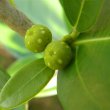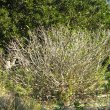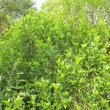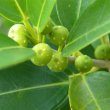Ficus burtt-davyi
| Botanical Name | Ficus burtt-davyi |
|||||||||||
| Family | Moraceae - The fig and mulberry family. |
|||||||||||
| Pronunciation | FY-kus burt-DAY-vee-eye |
|||||||||||
| Common Name(s) |
English: Scrambling Fig; Veld Fig
Afrikaans: Veldvy; Veldwildevy
IsiXhosa: Uluzi; Umdendekwana
IsiZulu: Uluzi; Umthombe
|
|||||||||||
| Plant Group |
|
|||||||||||
| Plant Size |
|
|||||||||||
| Position |
|
|||||||||||
| General Information |
|
|||||||||||
| Specific Information | Ficus Burtt-davyi grows as a shrub, climber or small tree. The glossy green leaves are more or less oval in shape and can vary in size from about 2 to 10 cm in length, depending on its habitat. The fruits are about 10 mm in diameter and are green mottled with white, turning yellowish when ripe. The fruits are much loved by birds. It is highly adaptable to a wide variety of habitats and has even been known to grow on larger trees (epiphytic) as a strangler fig, as well as on rocks (epilithic) where the roots are able to split the rocks in their search for nutrients. I have never really noticed that I have never seen a flower on a fig tree. Here's why: Fascinating facts about figs: The fig we eat is not a fruit but an inside-out flower stalk containing many flowers. This 'container' has a small opening at one end. Through this opening a small female wasp enters and lays her eggs in special infertile flowers, while unintentionally pollinating the fertile flowers and gathering pollen in special sacs. She then leaves through the opening again and carries the pollen to another fig. To add to this intricacy, each species of fig has its own specific species of wasp that pollinates it.
Ficus burtt-davyi is pollinated by a tiny wasp of about 1.5 mm long called Elisabethiella baijnathi. |
|||||||||||
| Ad Break | ||||||||||||
| Flowers | ||||||||||||
| Description | See comment above in Specific information. |
|||||||||||
| Season |
|
|||||||||||
| Colour | ||||||||||||
| Growth Rate |
|
|||||||||||
| Plant Uses |
|
|||||||||||
| Distribution and Habitat | along the coastal belt from the eastern part of the Western Cape, through the Eastern Cape to KwaZulu-Natal, and north into Mozambique, in dune forest, thicket, scrub, coastal swamp forest and on sand dunes, and in Savanna on rocky outcrops and cliffs |
|||||||||||
| Planting Suggestions | Plant Ficus burtt-davyi in full sun or light to partial shade in well drained soil, well away from permanent structures, paving and pools. It can be grown over rocks as an unusual feature in a rock garden, will adapt to a container and is commonly grown as a successful bonsai. It is salt tolerant and can be grown on coastal dunes, where it will seldom grow more than a meter high. Unless in a container, I would not suggest this plant for smaller gardens. The old method of digging a deep hole and filling it with soil and compost has resulted in many trees failing to thrive, dying, rotting at the base or worse still, falling over in later years due to poor root development. Refer to the following sites for the best method of planting trees: International Society of Arboriculture: New Tree Planting Tree People: Plant the right way For those of you who have a clay problem try: |
|||||||||||
| Medicinal Uses | In earlier times the bark was pounded and woven into sleeping mats. |
|||||||||||
| Ad Break | ||||||||||||










Comments
ficus seeds
Hi there, I would like to get some ficus seed off you, are you able to send to the USA?
regards
Jared
Ficus seeds
Hi Jared
Sorry but I do not have the necessary permits to export plant matter. Try silverhillseeds.co.za. They are an export seed company and have 15 different ficus species in their catalogue.
Regards
Lorraine
Image of Ficus burtt-davyi fruit
Hi Lorraine, Would you be prepared to release your image of the green fruit to be used on Wikipedia? It would improve the page on Ficus burtt-davyi tremendously.
regards
Paul Venter
Does Ficus burtt-davyi plant
Does Ficus burtt-davyi plant has any other documented or undocumented medicinal use apart from the bark being pounded and woven into sleeping mats.
Uses of Ficus burtt-davyi
Hi Muyiwa
None that I have been able to find.
Kind regrds
Lorraine
The fig fruits, important as
The fig fruits, important as both food and traditional medicine, contain laxative substances, flavonoids, sugars, vitamins A and C, acids and enzymes. However, figs are skin allergens, and the latex is a serious eye irritant. - Wikipedia
Ficus burtt-davyi
Hi Paul
Thanks for your comment. Please could you give me the exact link to this information as I could not trace it. I must be sure that it refers precisely to Ficus-burtt-davyi and not to the Ficus family in general.
Kind regards
Lorraine
Fig latex allergy
Hi Lorraine, I know of no reliable sources singling out Ficus-burtt-davyi as an allergen for human eyes - the sources I consulted do not specify which species. I suspect you can safely assume that the pharmacological action of fig latex is going to be pretty much the same for all figs.....
USES of Ficus burtt-davyi
Hi Paul
Thanks again for your input.
However, to get back to the original question as to whether there are any other uses of this particular species of fig. I think it has now been established that we have not come across any documented information describing the use of Ficus burtt-davyi, other than that which has been stated in the above text.
Kind regards
Lorraine
producing figs
Hi please could you tell me when these plants produce figs? How often in a year and which seasons? Thanks :)
Fig growth
Hi Calyn
As mentioned in the above text, figs are produced some time during the period from winter to summer, dependant on local conditions.
Kind regards
Lorraine
Discuss this plant
Share knowledge, ask a question or give an experience.